1544 Search Results for link up
August 10, 2014
by Carole Zangari -
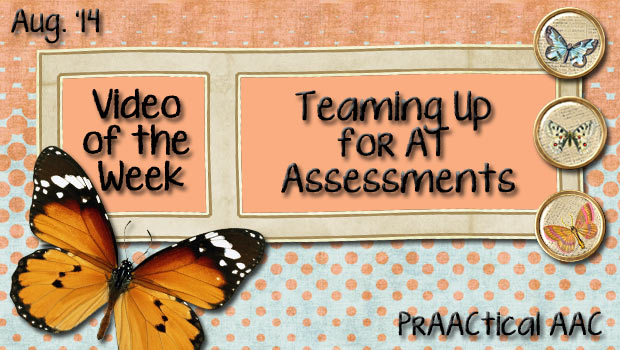
Allyson Robinson, SLP at the Oklahoma ABLE Tech Project, shares some thoughts on working as a team to conduct AT assessments that draw on the Quality Indicators for AT. Direct link to video: https://www.youtube.com/watch/?v=s3r8M-lFQfs
July 8, 2014
by Carole Zangari -
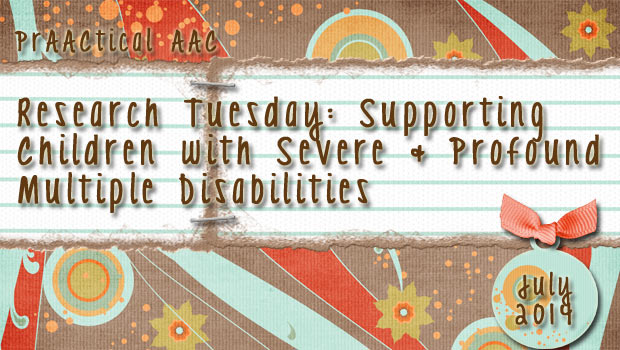
What do we know about the best ways to provide communication support to individuals with severe and profound multiple disabilities (PMLD)? PMLD is a term that generally refers to people who experience profound cognitive limitations in addition to sensory and/or physical disabilities. Many of these individuals have complex medical histories and chronic health concerns. Often, the communication difficulties experienced by individuals with PMLD cause them to be isolated and excluded from many social and educational opportunities. Despite their many challenges, there is evidence to suggest that AAC supports can help these children develop their communication skills. Not much is known, however, about how to structure the AAC intervention to maximize learning. In this study, Harding and her colleagues sought to reduce isolation and promote personal autonomy by providing AAC supports to two children with PMLD. As other researchers have demonstrated the positive impact of AAC on people with PMLD,... [Read More...]
May 21, 2014
by Carole Zangari -
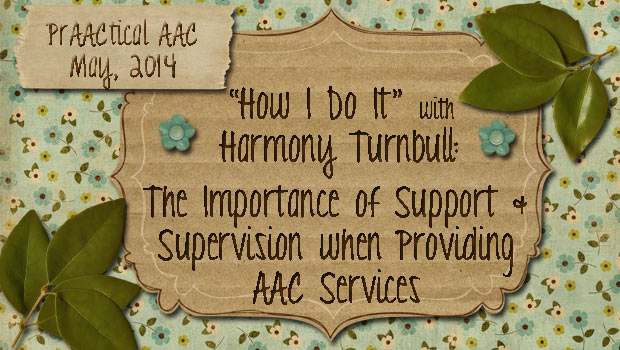
We are so thrilled to have a guest post today, from Australian SLP Harmony Turnbull. Harmony is a Consultant Speech Pathologist for Ageing, Disability and Home Care in NSW, Australia. In her role, she provides support and supervision to senior speech pathologists, carries a small caseload of people with complex needs and provides expert consultancy for management. She has specialised in supporting people with disabilities including complex communication needs for 11 years and is addicted to networking. She can often be found sharing her knowledge and asking many questions on Facebook and Twitter (@SP_Harmony). Harmony is passionate about the work speech/language pathologists can do to improve the quality of life for people with disabilities. The Importance of Support and Supervision when Providing AAC Services Scenario – Jane Jane is an SLP who has been working with people with disabilities for over 5 years, including people with complex communication needs. Her caseload... [Read More...]
April 22, 2014
by Carole Zangari -
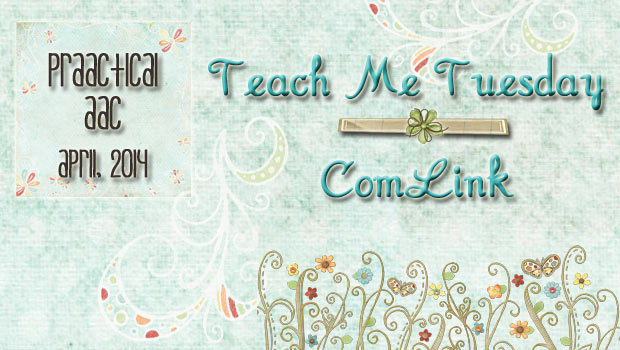
Welcome to Teach Me Tuesday, featuring the ComLink from FRS-Solutions. The ComLink has different models and they can run two kinds of communication software, The Grid 2 (Standard) and Viking Communicator (Alternative). There are videos and resources for both models in this post. ComLink LT3G Quick Start Guide ComLink ST3G Quick Start Guide ComLink 3G Quick Start Guide Where to Go For Help ComLink Ultra Quick Start Guide Where to Go For Help If you know of any other helpful training resources, please let us know via the comments so that all can benefit.
March 2, 2014
by Carole Zangari -
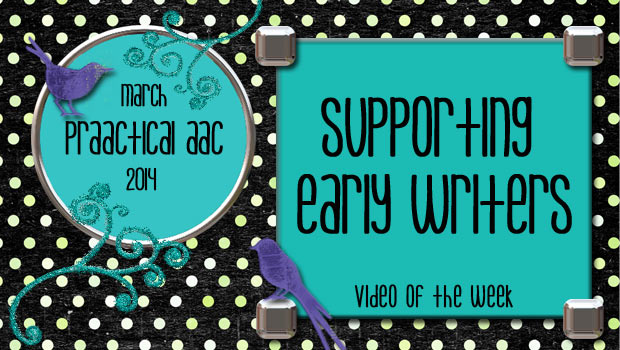
Can students with significant communication and other challenges learn to write? We think so, and love the approach discussed by Dr. Janet Sturm in this video. Direct Link to Video: http://vimeo.com/75607425
February 11, 2014
by Carole Zangari -
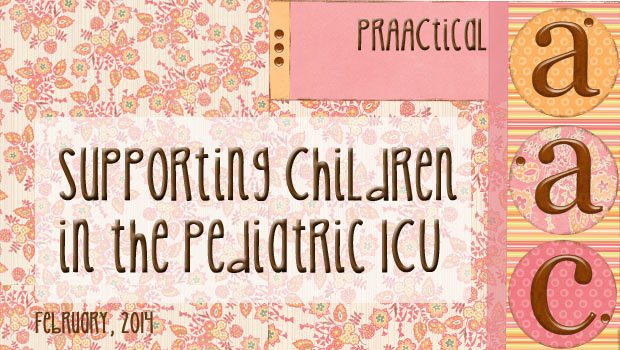
If there is anything scarier than having a very sick child in the ICU, it has to be when that child has no means of communication. In this Research Tuesday post, we join the efforts spearheaded by Rachel Wynn of Gray Matter Therapy to share an article that discusses the issues and presents some solution strategies. When we think of research studies in SLP, we think of experimental designs and randomized controlled trials (RCTs). In AAC, group research designs are uncommon because of the immense heterogeneity of this clinical population. Even limiting the study to one single disorder and age group, say teenagers with dysarthria secondary to cerebral palsy, contains too much heterogeneity for most group research. Instead, we see more single subject design experimental studies (SSEDs) in AAC. When well-designed, SSEDs have strong experimental control and allow researchers to answer causal questions, such as “did the treatment (e.g., teaching... [Read More...]
February 10, 2014
by Carole Zangari -
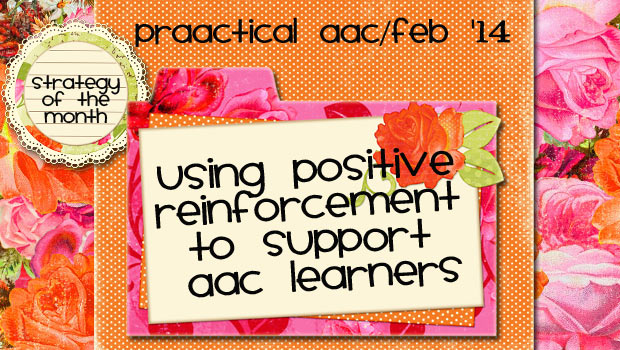
In terms of reinforcement, Jamie kept me on my toes. Initially, she preferred to be by herself so that she could do her own thing without any demands placed on her. Solitary time is not our favorite way to reinforce desired behavior, but it was a start. Jamie earned little bits of free time where she could have some uninterrupted play. Then, she seemed to like anything that she could line up. No sweat. (This is progress! We were much happier to see her desire things as opposed to the absence of company. We had lots of things that we could use and she loved the novelty of materials we presented…for short awhile). Quickly, that morphed into things that she could line up that had letters. Got it! (We can repurpose some alphabet puzzles/games and we’re good!). Then, things got interesting. One week there was an intense love of... [Read More...]
January 24, 2014
by Carole Zangari -
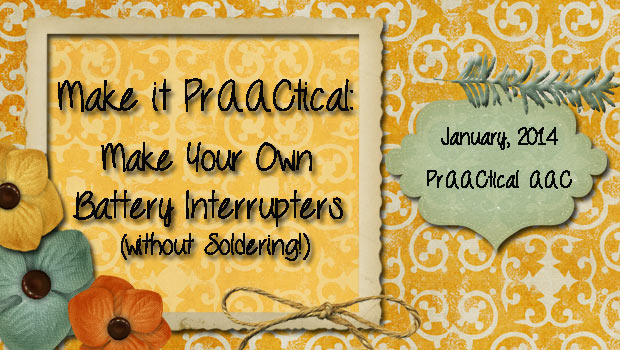
Battery interrupters used to be cheap. I know I’m dating myself, but who else remembers getting them for under five bucks? They are such useful little buggers to have around so that battery-operated toys, CD players, etc can be quickly adapted for switch use. We’ve talked about adapting battery-operated toys for switch use, but you always need a battery interrupter. We were thrilled to come across this no-solder instructable for making them ourselves and figured that there have to be a few other DIY-loving prAACtical folks about there. Take a look. Direct Link: http://www.instructables.com/id/No-Solder-Battery-Interrupter/
December 11, 2013
by Carole Zangari -
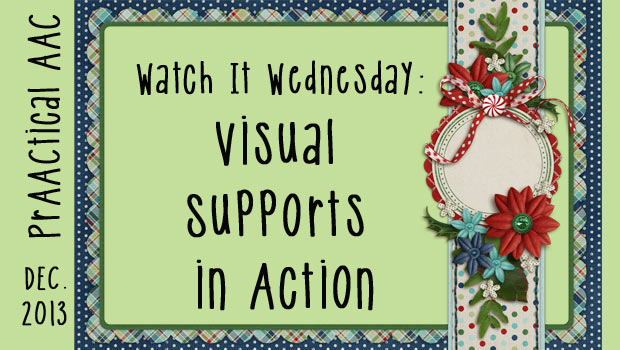
Visual supports are good teaching for ANY child, but particularly if there are issues with language processing. Check out this great example from The Teaching Channel. Direct Link: https://www.teachingchannel.org/videos/visual-cues-in-the-classroom
November 22, 2013
by Carole Zangari -
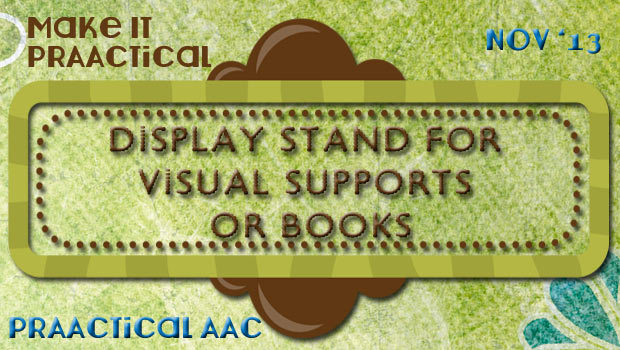
In an earlier post, we shared a wonderful video on making a portable stand for a communication book. Today, we look at a different approach to book stands, which would be great for the reading material or visual supports that the communicator needs to see. We love that it is lightweight, easy to transport and store, and inexpensive to make. Hats off to the wonderful team at AT in New Hampshire for this terrific video. The direct link is: https://www.youtube.com/watch?v=1EeX7bIKiEU.









